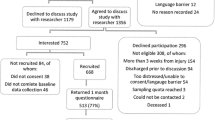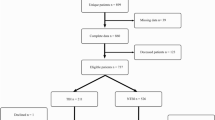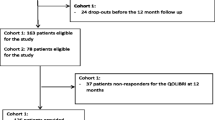Abstract
Background and aims
The aim of this study was to improve health-related quality of life (HRQOL) related to depression, anxiety, pain, physical functioning and social aspects for severely injured trauma survivors by early onset cognitive behavioural therapy applied on the surgical ward.
Materials and methods
The study was a randomised, controlled study. Of 298 primary screened patients 171 were eligible and randomised. Ninety-two patients adhered to follow-up investigations at 6 and 12 months. Main outcome measure was a sum score according to O’Brien calculated of five different questionnaires (BDI, SF-36, STAI, SCL 90R, F-SOZU-22).
Results
The sum score for overall HRQOL did not show significant group differences at follow-up. Effects on HRQOL sub-dimensions within groups have been found. In the dimension of depression therapy group showed significant improvement from the first measurement to discharge from hospital (p < 0.001), 6 MFU (p = 0.004) and to 12 MFU (p = 0.013). Measures of anxiety showed significant improvement for the therapy group at discharge from hospital (p = 0.001). In the control group there was only a significant reduction in depression and anxiety from surgical ward to discharge (p = 0.013/p = 0.031).
Conclusions
Early onset cognitive therapy is not effective in improving overall HRQOL of severely injured patients but shows promising effects on depression and anxiety up to 12 months after trauma.



Similar content being viewed by others
References
Working Group “Polytrauma” of the German Society for Trauma Surgery (DGU) (2006) Annual report of the DGU trauma registry 2006
Bouillon B, Neugebauer E (1998) Outcome after polytrauma. Langenbecks Arch Surg 383(3–4):228–234
Pirente N, Gregor A, Bouillon B, Neugebauer E (2001) Lebensqualität schwerstverletzter Patienten ein Jahr nach Trauma-eine matched pair Studie im Vergleich zu einer gesunden Kontrollgruppe. Unfallchirurg 104(1):57–63
Zettl RP, Ruchholtz S, Lewan U, Waydhas C, Nast-Kolb D (2004) Lebensqualität polytraumatisierter Patienten 2 Jahre nach Unfall. Notf Rett Med 7:547–553
O’Donnell ML, Creamer M, Pattison P, Atkin C (2004) Psychiatric morbidity following injury. Am J Psychiatry 161(3):507–514
Mayou R, Bryant B (2002) Outcome 3 years after a road traffic accident. Psychol Med 32(4):671–675
Barth J, Kopfmann S, Nyberg E, Angenendt, Frommberger U (2005) Posttraumatic stress disorders and extent of psychosocial impairments five years after traffic accident. GMS Psychosoc Med 2:Doc 09
Koren D, Arnon I, Klein E (1999) Acute stress response and posttraumatic stress disorder in traffic accident victims: a one-year prospective, follow-up study. Am J Psychiatry 156(3):367–373
Mayou RA, Ehlers A, Bryant B (2002) Posttraumatic stress disorder after motor vehicle accidents: 3-year follow-up of a prospective longitudinal study. Behav Res Ther 40(6):665–675
Blanchard EB, Hicking EJ, Freidenberg BM, Malta LS, Kuhn E, Sykes MA (2004) Two studies of psychiatric morbidity among motor vehicle accident survivors 1 year after the crash. Behav Res Ther 42(5):569–583
Joy D, Probert R, Bisson JI, Shepherd JP (2000) Posttraumatic stress reactions after injury. J Trauma 48(3):490–494
Wang CH, Tsay SL, Bond AE (2005) Post-traumatic stress disorder, depression, anxiety and quality of life in patients with traffic-related injuries. J Adv Nurs 52(1):22–30
Zatzick D, Roy-Byrne P, Russo J, Rivara F, Droesch R, Wagner A et al (2004) A randomized effectiveness trial of stepped collaborative care for acutely injured trauma survivors. Arch Gen Psychiatry 61(5):498–506
Bisson JI, Shepherd JP, Joy D, Probert R, Newcombe RG (2004) Early cognitive-behavioural therapy for post-traumatic stress symptoms after physical injury. Randomised controlled trial. Br J Psychiatry 184:63–69
Blanchard EB, Hickling EJ, Devineni T, Veazey CH, Galovski TE, Mundy E et al (2003) A controlled evaluation of cognitive behavioral therapy for posttraumatic stress in motor vehicle accident survivors. Behav Res Ther 41:79–96
Blanchard EB, Hickling EJ, Malta LS, Freidenberg BM, Canna MA, Kuhn E, Sykes MA, Galovski TE (2004) One and two year prospective follow-up of cognitive behaviour therapy or supportive psychotherapy. Behav Res Ther 42(7):745–759
Bryant RA, Harvey AG, Dang ST, Sackville T, Basten C (1998) Treatment of acute stress disorder: a comparison of cognitive–behavioral therapy and supportive counseling. J Consult Clin Psychol 66(5):862–866
Bryant RA, Moulds ML, Nixon RV (2003) Cognitive behaviour therapy of acute stress disorder: a four-year follow-up. Behav Res Ther 41(4):489–494
Bryant RA, Sackville T, Dang ST, Moulds M, Guthrie R (1999) Treating acute stress disorder: an evaluation of cognitive behavior therapy and supportive counseling techniques. Am J Psychiatry 156:1780–1786
Fecteau G, Nicki R (1999) Cognitive behavioral treatment of post traumatic stress disorder after motor vehicle accident. Behav Cogn Psychother 27:201–214
Ehlers A, Clark DM, Hackmann A, McManus F, Fennell M, Herbert C et al (2003) A randomized controlled trial of cognitive therapy, a self-help booklet, and repeated assessments as early interventions for posttraumatic stress disorder. Arch Gen Psychiatry 60(10):1024–1032
O’Donnell ML, Creamer M, Pattison P (2004) Posttraumatic stress disorder and depression following trauma: understanding comorbidity. Am J Psychiatry 161(8):1390–1396
Maercker A, Zöllner T, Menning H, Rabe S, Karl A (2006) Dresden PTSD treatment study: randomized controlled trial of motor vehicle accident survivors. BMC Psychiatry 6:29
Bisson J, Andrew M (2005) Psychological treatment of post-traumatic stress disorder (PTSD). Cochrane database of systematic reviews 2005, Issue 2. Art. No. CD003388
Association for the Advancement of Automotive Medicine (1990) The Abbreviated Injury Scale (AIS), 1990 Revision. Barrington, IL
Teasdale B (1974) Assessment of coma and impaired consciousness: a practical scale. Lancet 2:81–84
Baker SP, O’Neill B, Haddon W, Long WB (1974) The injury severity score: a method for describing patients with multiple injuries and evaluating emergency care. J Trauma 14:187–196
Neugebauer E, Troidl H, Wood-Dauphinee S, Eypasch E, Bullinger M (1991) Quality of life assessment in surgery: results of the Meran consensus development conference. Theor Surg 6:123–137
Ware JE, Sherbourne CD (1992) The MOS 36-item short-form health survey (SF-36). I. Conceptual framework and item selection. Med Care 30(6):473–483
Franke G (1995) Die Symptom-Checkliste von Derogatis-Deutsche Version. Beltz Test, Göttingen
Hautzinger M, Bailer M, Worall H, Keller F (1994) Beck-Depressions-Inventory (BDI). Hans Huber, Bern
Laux L, Glanzmann P, Schaffner P, Spielberger CD (1981) State-T rait-Angstinventar (STAI). Testzentrale, Göttingen
Bullinger M (1995) German translation and psychometric testing of the SF-36 health survey: preliminary results from the IQOLA project. International quality of life assessment. Soc Sci Med 41(10):1359–1366
Acknowledgment
Prof. Lehmkuhl and Dr. Melchers, Clinic for Psychiatry and Psychotherapy of Children and Adolescents, University of Cologne, for advice in construction of the treatment modules and supervision of psychotherapists. Prof. Lehmacher and Bettina Buchheister, IMSIE, University of Cologne, for statistical support.
Thanks to all cooperating nurses and surgeons on the wards of the participating hospitals. Our sources of support are (1) the Federal Ministry of Education and Research (Bundesministerium für Bildung, Wissenschaft, Forschung und Technologie, BMBF, Kennziffer: 01 KO 9517/9) from 01/07/1996; (2) the German Research Foundation (Deutsche Forschungsgemeinschaft, DFG, Kennziffer NE 385/6-1 und 6-2) from 01/01/1999 until 31/12/2000; (3) the Medical Faculty, University of Cologne, Köln-Fortune Programme.
Author information
Authors and Affiliations
Corresponding author
Rights and permissions
About this article
Cite this article
Pirente, N., Blum, C., Wortberg, S. et al. Quality of life after multiple trauma: the effect of early onset psychotherapy on quality of life in trauma patients. Langenbecks Arch Surg 392, 739–745 (2007). https://doi.org/10.1007/s00423-007-0171-8
Received:
Accepted:
Published:
Issue Date:
DOI: https://doi.org/10.1007/s00423-007-0171-8




